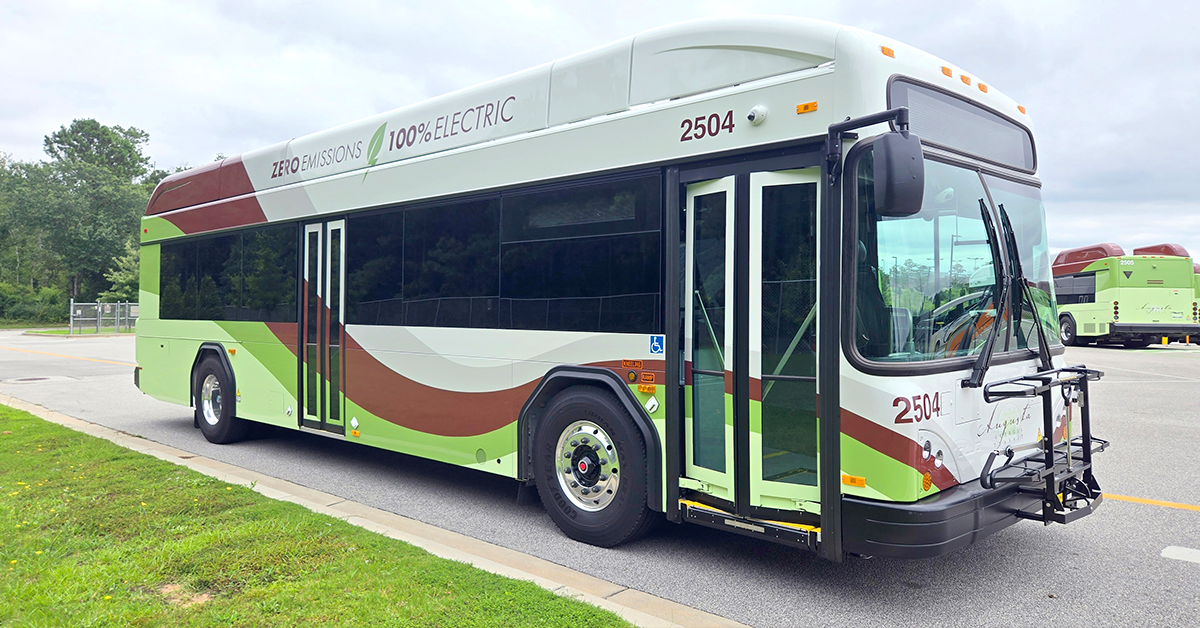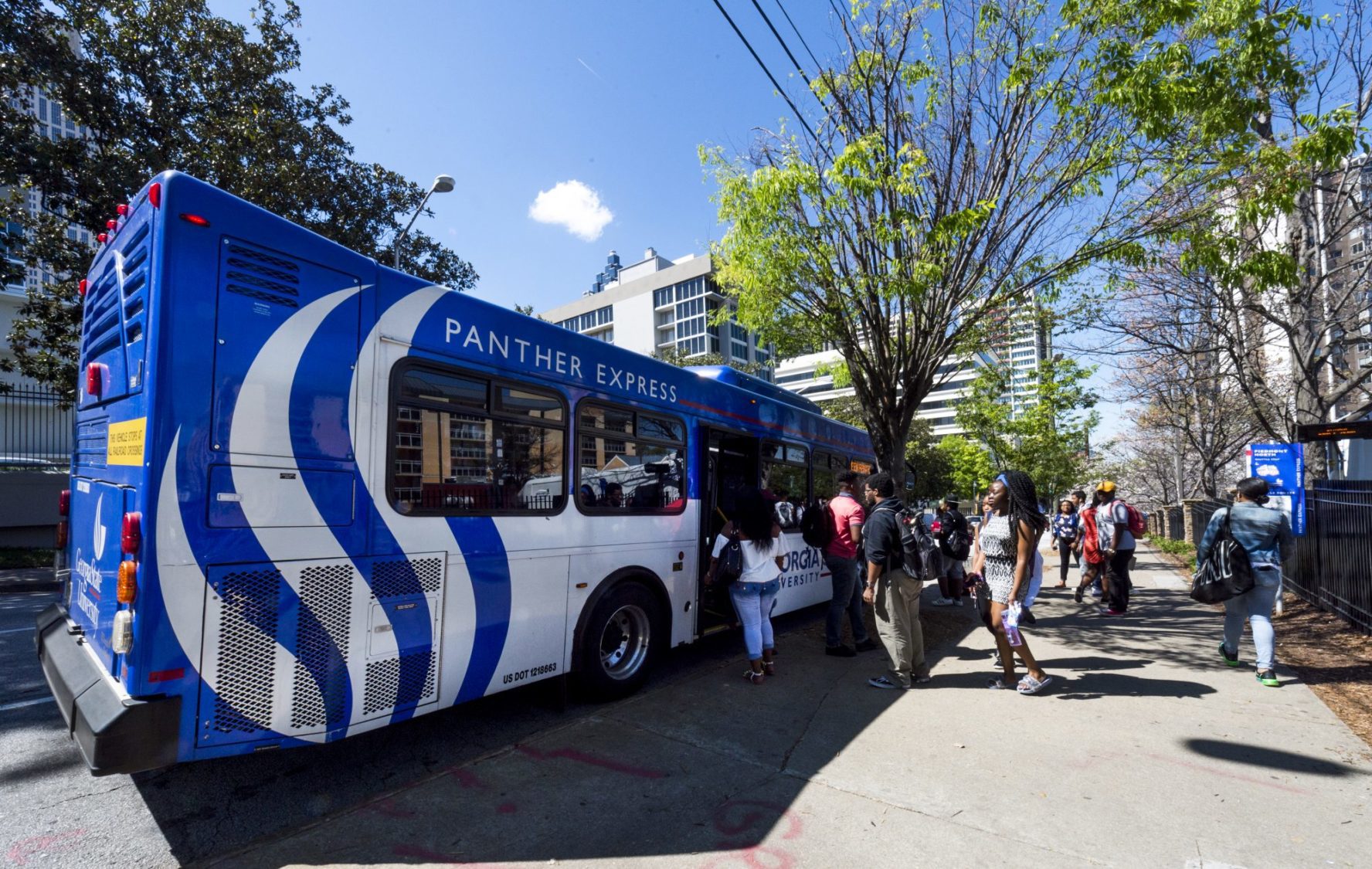Blueprint Report Provides Guidance on Reducing Costs of Electric School Bus Charging

FOR IMMEDIATE RELEASE
April 11, 2023
BLUEPRINT REPORT PROVIDES GUIDANCE ON REDUCING COSTS
OF ELECTRIC SCHOOL BUS CHARGING
The Center for Transportation and the Environment, NV5, and The Mobility House partnered to create a lowest cost to charge blueprint to help school districts around the US prepare for fleet electrification.
Atlanta, GA - The California Energy Commission (CEC) awarded a $199,903 grant to Center for Transportation and the Environment (CTE), NV5, and The Mobility House (TMH) to determine the lowest cost method for a California school district to charge 100% of its electric school bus (ESB) fleet based on current operations. Stockton Unified School District (SUSD) fleet was used as the basis of the study.
While this study was framed by California rate structures, particularly electric vehicle Time-of-Use tariffs and the Net Energy Metering 3.0 tariff for on-site solar generation, the results are broadly applicable to other school districts when planning for infrastructure to support ESBs.This project lays the groundwork for large fleets of ESBs by evaluating various charging approaches for full electrification, determining lowest total cost of infrastructure, and evaluating measures to offset charging energy cost through charge energy management and distributed energy resource options to accelerate ESB adoption throughout the state of California.The rapid transition to ESBs is happening alongside significant changes in how the electric grid operates.
In the future, fleets will likely be able to send electricity back to the grid under Vehicle-to-Grid (V2G) programs. The landscape of incentives for solar production has dramatically changed as well with the anticipated transition in California from Net Energy Metering 2.0 to Net Billing Tariff (commonly referred to as NEM3.0). The NEM3.0 tariff strongly incentivizes self-consumption of on-site solar energy production, which will influence how district fleet managers orient their charging strategy. Scheduling ESB charging to prioritize solar photovoltaic (PV) self-consumption will be the key to making solar installations under NEM3.0 financially sound.Through this analysis project, the team arrived at the following conclusions:
- Alternating Current (AC) Direct Current (DC) Charging: AC charging is sufficient for the charging scenarios evaluated for SUSD, as higher power DC charging is not necessary. The hardware, installation, and ongoing costs for AC charging is lower compared to DC charging.
- Charge Energy Management (CEM): The use of CEM results in significant savings by limiting charging spikes and avoiding high demand charges. In the 100% AC-charging scenario, CEM is modeled to save the District over $160,000 per year, or roughly 40% of energy costs from charging. CEM will be critical in coordinating charging timing with Time-of-Use tariffs and energy production from a solar PV Coordinating charging with solar production makes PV a viable option under NEM3.0. In this study, without CEM, the majority of PV production is sent back to the grid at a low value and unmanaged charging occurs during peak Time-of-Use rates.
- Onsite Distributed Energy Resources (PV and PV+BESS): PV under NEM3.0 is only justified on a cost savings basis if paired with CEM to optimize ESB charging to periods when PV generation is available; therefore, reducing exported PV generation. Charging the ESBs with a PV system sized to offset 90% annual consumption results in lower costs to SUSD compared to a baseline without PV where ESBs charge primarily overnight with a CEM. Using a stationary battery energy storage system (BESS) to store and use PV generation was not found to be cost-effective due to the current high cost of BESS. Using CEM to shift ESB charging and manage demand was found to be a more cost-effective solution for SUSD. If a school district is lucky enough to secure a NEM2.0 solar PV system, solar PV sized to 90% offset is cost effective with or without CEM.
- V2G Charging Potential Revenue: Vehicle-to-Grid (V2G) charging can produce revenue, but it is unclear if this is enough to justify additional costs for the technology required to monetize V2G revenue. The study assumed Level 2 V2G charging will be available. To offset the added costs of V2G on Level 2 19.2 kW AC charging, SUSD's V2G exported energy must, on average, be valued at $0.19/kWh if receiving PG &E's V2G pilot incentives, and $0.29/kWh without incentives. If SUSD needed to upgrade to DC charging to achieve V2G, the incremental equipment costs may not be justified by the savings. This is a rapidly evolving field however and should be reconsidered as new options and incentives become available, and the process is more mainstream. Where possible, the team recommends leaving open the option for future V2G revenue.
The project team recommends school districts install AC charging, unless there is a need for DC charging, and utilize a CEM system to limit charging to the most cost-effective times. The team also found that under the new NEM3.0 tariff, solar PV systems installed without CEM do not provide positive 25-year Net Present Value savings for school bus charging if the majority of charging will occur overnight. Additionally, the added costs associated with V2G technology diminish returns and make it hard to justify the potential cost benefits at this time. V2G use should continue to be researched as policies, V2G tariffs, and technology can change to make bi-directional charging more favorable.
"CTE is proud to have led this important work. There are school bus fleet managers across the country needing to quickly make complex decisions regarding future infrastructure. We hope this provides some guidance in the quickly evolving utility landscape and charging ecosystem." - Erik Bigelow, Director of Midwest Operations, CTE"Stockton Unified has led the way in demonstrating a successful approach to implementing charging infrastructure for their electric school bus fleet.
This report clearly demonstrates an economical path forward to a 100% zero emissions fleet based on proven technology and solid analysis." - Greg Hintler, CEO North America, The Mobility HouseRead the Stockton Unified School District Lowest Cost to Charge Blueprint→. Read the Final Project Report→.
ABOUT CTE
The Center for Transportation and the Environment is a 501(c)(3) nonprofit organization with a mission to improve the health of our climate and communities by bringing people together to develop and commercialize clean, efficient, and sustainable transportation technologies. CTE collaborates with federal, state, and local governments, fleets, and vehicle technology manufacturers to complete our mission. If interested in learning more about CTE, please visit cte.tv→.
ABOUT THE MOBILITY HOUSE
The Mobility House is a world leader in smart charging solutions. Our technology platform ChargePilot® enables reliable and efficient charging of electric vehicle fleets and vehicle grid integration using intelligent charging and energy management. ChargePilot® has been implemented in more than 1200 charging depots across North America and Europe with leading electric bus operators, delivery service fleets and on corporate campuses. For more information, visit mobilityhouse.com→.
ABOUT NV5
Sage Energy Consulting is now part of NV5's Clean Energy group, which helps clients plan and implement their transition to zero-emission transportation across light-, medium-, and heavy-duty applications.
ABOUT THE CALIFORNIA ENERGY COMMISSION
The California Energy Commission is the state's primary energy policy and planning agency. It has seven core responsibilities: advancing state energy policy, encouraging energy efficiency, certifying thermal power plants, investing in energy innovation, developing renewable energy, transforming transportation, and preparing for energy emergencies. For more information, visit https://www.energy.ca.gov→.
Contact
Center for Transportation and the Environment
Kate Mason
kate@cte.tv
615.419.5185
The Mobility House
Dylan Gasperik
dylan.gasperik@mobilityhouse.com
650.629.4262





